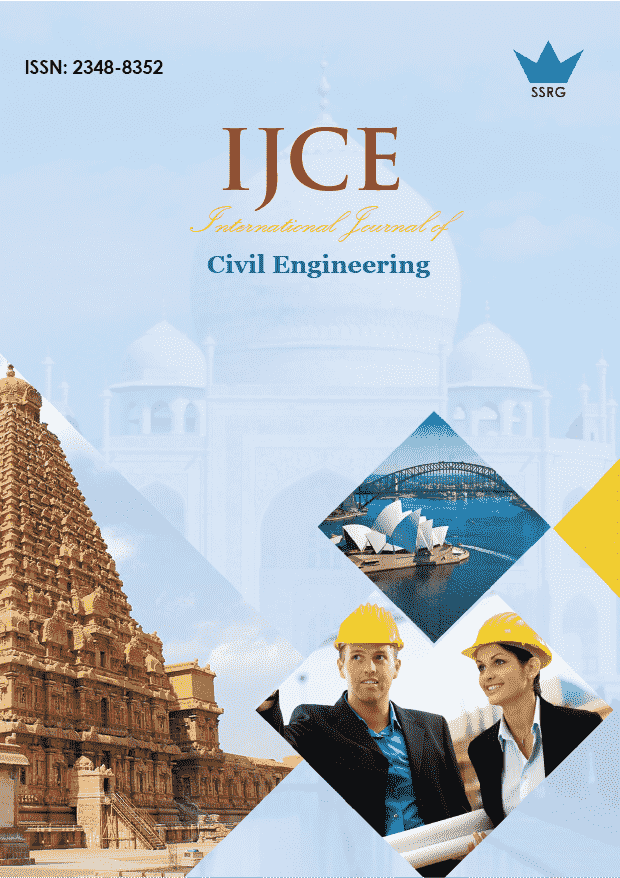Performance of high Strength Concrete Using Oyster Shell Ash as Partial Replacement for Cement

| International Journal of Civil Engineering |
| © 2019 by SSRG - IJCE Journal |
| Volume 6 Issue 6 |
| Year of Publication : 2019 |
| Authors : Ephraim M. E , ThankGod. O, Gbinu. K.S |
How to Cite?
Ephraim M. E , ThankGod. O, Gbinu. K.S, "Performance of high Strength Concrete Using Oyster Shell Ash as Partial Replacement for Cement," SSRG International Journal of Civil Engineering, vol. 6, no. 6, pp. 33-38, 2019. Crossref, https://doi.org/10.14445/23488352/IJCE-V6I6P107
Abstract:
In this study, the possibility of using oyster shell ash (OSA) to partially replace cement in the design of High strength concrete (HSC) was investigated. Six mix ratios were used to investigate strength at replacement level of 7.5, 10, and 15 percent of cement at W/B ratios of 0.22, 0.25, and 0.27; Results showed that there was an increase in strength in all mixes as the days of wet curing increased but decreased as the percentage of Oyster shell ash increased with the least strength of 54MPa at 28 days for 0.27 water- binder ratio with 15% replacement level. The value of 72.2MPa was attained at 7.5% replacement at 0.22 water-binder ratio of mix MA1, while the 0% (control concrete) recorded 74.22MPa at 28 days of wet curing
Keywords:
High Strength Concrete, Oyster Shell Ash,
References:
[1] Obunwo, U.E., Ngekpe, B.E., Jaja, W.T.G & Obunwo, C, Workability and Mechanical Properties of High-Strength Self-Compacting Concrete Blended with Metakaolin. SSRG International Journal of Civil Engineering., 5(10),(2018),17-22
[2] Egwuonwu, W., C., Akobo I., Z., S. and Ngekpe, B., E.(2019). Effect of metakalin as a Partial Replacement for cement on the compressive strength Concrete at Varying Water/Binder Ratios. SSRG International Journal of Civil Engineering 6 (1),1- 6.
[3] Ez-zaki, H Diouri, A., Kamali-bernard, S., and Sassi, O, (2016) Composite cement mortars based on marine sediments and oyster shell powder, materConstr 66(321),751-764.
[4] Kuo, W., Wang, H., Shu, C., & Su, D.(2013).
Engineering properties of controlled low-strength
Materials containing waste oyster shells. Construction and Building Material, 46,(2013),128-133.
[5] Lertwahanaruk, P., Makul, N. and Siripattarapraval, Cultilization of ground waste seashells in cement mortars for masonry and plastering J. environ. Manage. 111, .(2012),133-141.
[6] Barisua, E. Ngekpe, Iboroma, Z.S Akobo, Chigozie, M. Onyegbadue, The mechanical properties of roller-compacted concrete blended with microsilica. SSRG International Journal of Civil Engineering 6(6),1-6, (2019).
[7] Umoh, A. A. & Olusola, K. O. (2012) Effect of
different sulfate types and concentrations on
compressive strength of periwinkle shell ash blended cement concrete. International Journal of Engineering & Technology, 12(5), 1017.
[8] Varhen, C. Carrillo, S and Ruiz, G.Experimental investigation of Peruvian scallop used as fine aggregate in concrete, constr. Build. Mater. (136), (2017), 533-540.
[9] Yao, Z., Chen, T., Li, H., Xia, M., Ye, Y., & Zheng, H, Mechanical and thermal properties of polypropylene composites filled with modified shell waste. Journal J. Hazard Material, 262,(2013),212-217.
[10] Zhong, B., Zhou, Q., Chan, C and Yu, Y., Structure, and property characterization of oyster shell cementing material, chin. J. struct. Chem. 31(1), (2012),85-92.

 10.14445/23488352/IJCE-V6I6P107
10.14445/23488352/IJCE-V6I6P107